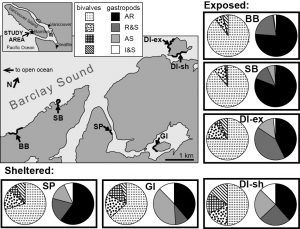Projects
Taphonomy and Predation
Leighton et al. 2016
An ongoing focus of research in our lab has been evaluating different measures of predation. In particular, I’ve been an advocate for measuring predation traces for some time. While much of our research has been focused on repair frequency (check out the Molinaro et al. study for a modern baseline study of repairs), a major concern with using repairs is that repairs are, by definition, the result of failed attacks. So we’ve also explored other predation traces, and recently, we finished a project examining shell fragmentation rates in the modern.
There is no shortage of shell fragments in many marine systems, both modern and ancient. However, opinions on what is the primary cause of fragmentation differ a lot, and often are dependent on the researcher’s background: sedimentologists tend to assume that most fragmentation is a function of transport, whereas marine biologists often assume that fragmentation is a function of crushing predation. In fact, this project started as the result of a friendly disagreement during a committee meeting for one of my Ph.D. students. The big problem with fragmentation is that everyone has assumed that we can’t distinguish fragments caused by transport from those that originated during predation. Using a combination of tumbling experiments and modern field data collected from localities of known wave-energy and predation intensity, we demonstrated that (a) transport-fragments will have at least one rounded edge, and that predation-fragments will have only sharp or intact edges; and (b) that the relative proportions of these two mechanisms varies predictably with existing wave-energy and predation gradients. This result was obtained independently for both bivalves and gastropods.


For bivalves (pies on left of each box), dots indicate All-Rounded (AR) or Rounded & Sharp (R&S) = transport. Stripes indicate All-Sharp (AS) or Intact & Sharp (I&S) = predation.
For gastropods (pies on right side of each box), darker shades indicate AR or R&S, while lighter shades indicate AS or I&S.
There is a greater proportion of transport-fragments in high-energy settings, whereas predation-fragments are more common in the low-energy, high-predation settings than in the high-energy settings. This is good news – it should be possible to rank samples in terms of predation pressure. Curiously, this sort of approach has already been used in paleontological studies, but this is the first example providing a modern baseline to ground-truth the method. The paper was published in the Journal of the Geological Society (Leighton et al. 2016). Compare these results to our earlier work on repair, described below.